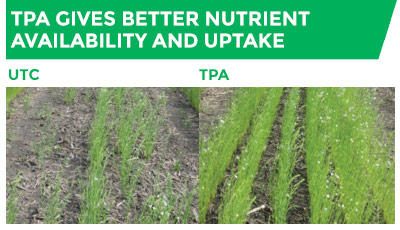Why pay attention to phosphorus when sowing into cold, wet soils?
During the fall of 2016, much of the Prairies experienced heavy rain and the ground remained saturated until winter. The arrival of unseasonably warm weather this spring is tempting many farmers to seed early, as they look to maximize yield potential and help manage the workload associated with seeding large acres. Those who have crops left in the field are even more anxious to get started, as dealing with swathed or still-standing crops will delay their seeding operation.
Farmers are seeding into cool or cold soils and often into wet conditions, which don’t allow for much availability of phosphorus, potassium or zinc, and this trio doesn’t become available until the soil temperature warms up to above 12 or 15 degrees Celsius. If they are seeding early, I believe the best thing farmers can do to get their crops off to a good start is to use a primer on the seed and a starter fertilizer in-furrow with the seed. This tactic is especially important this year as saturated soils are going to be slow to warm up.
Over many years of using the product on my own crop, I’ve witnessed first-hand the benefits of starter fertilizer. I’ve seen tremendous differences between crops supplied with starter versus the ones seeded without. Emergence was often faster and more even, and plants grown with a starter always revealed a larger root system. I’ve even tried starter fertilizer on crops with the poorest root systems, such as flax and durum, and the results were astonishing. I’ve always said if any crop would respond well to starter, it would be flax with its tiny roots.
Placing phosphorus close to the root tip of young seedlings is crucial as it provides readily available nutrients to promote early root growth and development. This guarantees the seedlings a head start over competitive weeds and builds a strong root system, able to tap into water and side-banded fertilizer. Efficient use of water and nutrients builds an optimum above-ground biomass, which helps the crop cope with early-season stress and gets it moving without delays through the various growth stages.
Starter fertilizer can either be supplied in an ortho- or poly-phosphate form, or a ratio of both. Phosphorus, in its ortho- form, is the most available form for uptake, but also the most prone to tie-up when applied to soils rich in calcium (alkaline soils), aluminum or iron (acidic soils), which immobilizes between 70 to 90 per cent of the applied phosphorus, making it unavailable to the crop. The use of products that improve the Cation Exchange Capacity (CEC), such as TPA and ImPhos, along with the starter fertilizer, helps free up the phosphorus and enhances its availability to the emerging seedlings.

“Our R&D group has been experimenting over the last few years with a variety of products that are able to make the phosphorus applied in the starter fertilizer more available,” says Dr. Abdel El Hadrami, Research and Development Director at OMEX. “We’ve seen 20 to 30 per cent improvement in the uptake of phosphorus in the plots treated with Starter P including TPA over the untreated checks across a wide variety of soil types and textures.”
In 2016, Russell Clark, Territory Manager for OMEX in Southern Alberta & Peace Region, tested the use of TPA with a liquid starter fertilizer used by one of his customers on barley and noticed tissue tests showed improved phosphorus uptake by 20 per cent and potassium by 40 per cent, as well as an improved uptake of all the other nutrients.
TPA does not protect phosphate only in the liquid ortho- form, but can also be applied onto the dry MAP/DAP or liquid 10-34-0. Due to its moderate CEC and biodegradability, TPA will last one season and prevent the creation of insoluble bounds between the negatively charged phosphorus and other positively charged cations in the soil (Ca++, Al+++, Fe++). TPA performs the same whether applied to acidic or alkaline soil.
For more information on how to incorporate TPA or Starter P fertilizer into your crop management plan contact your local retailer or OMEX representative.
